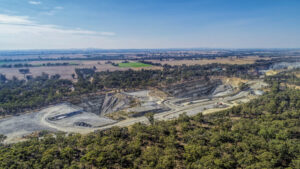Great Western’s ultrafine+ soil sampling results enhance Thunder Copper-Gold Target ahead of drilling

Pic: Bloomberg Creative / Bloomberg Creative Photos via Getty Images
Great Western Explorations’ latest infill and extensional ultrafine+ soil sampling results have upgraded the size and tenor of strong copper-gold anomalism at the Thunder Copper-Gold target in Western Australia, about 112km from Sandfire’s (ASX:SFR) DeGrussa Copper-Gold operation.
Analysis undertaken by the company and its consultant GCXplore has also enhanced the correlation of several pathfinder elements including silver, molybdenum, barium, bismuth, rhenium, antimony, selenium, tellurium, and zinc.
The zone of gold and copper anomalism features max values of 394ppm copper and 37.6ppb gold, extending over 3.3km.
An additional northwest trending copper-gold trend has been identified 3km to the northeast of Thunder.
Great Western (ASX:GTE) has now made applications for additional tenure covering the extension of the northwest trending copper-gold anomalism that has been highlighted by the infill and extensional ultrafine+ soil sampling programme.
Drilling to kick off in November
Thunder is located in the southern portion of the Yerrida Basin, which is currently being actively explored by Sandfire Resources on their 100% owned tenure and on the SFR-GTE Yerrida North Joint Venture ground, also by DGO Gold (ASX:DGO) on their 100% owned ground.
Thunder was initially identified as an area of high potential given its geological and structural setting of soft sediments intruded by mafic volcanic dykes adjacent to the intersection of two large faults
GTE believes Thunder copper-gold target is interpreted to be an analogue to the DeGrussa copper-gold deposit to the northwest, being a VMS model of mafic volcanics intruding Proterozoic sediments along large faults.
Plans are in place to carry out drilling in November.
Background
The ultrafine+ soil sampling program was undertaken to provide close-spaced soil geochemistry data that has since helped to refine drill targeting for an upcoming drill program.
During the September quarter 2021 Great Western (ASX:GTE) announced that the results of a moving loop electromagnetic (MLEM) survey had defined a large, conspicuous, discrete EM anomaly at Thunder.
The EM anomaly is some 800m in length from a depth of 100m with a shallow dip to the west.
This article was developed in collaboration with Great Western Exploration, a Stockhead advertiser at the time of publishing.
This article does not constitute financial product advice. You should consider obtaining independent advice before making any financial decisions.
Related Topics

UNLOCK INSIGHTS
Discover the untold stories of emerging ASX stocks.
Daily news and expert analysis, it's free to subscribe.
By proceeding, you confirm you understand that we handle personal information in accordance with our Privacy Policy.








